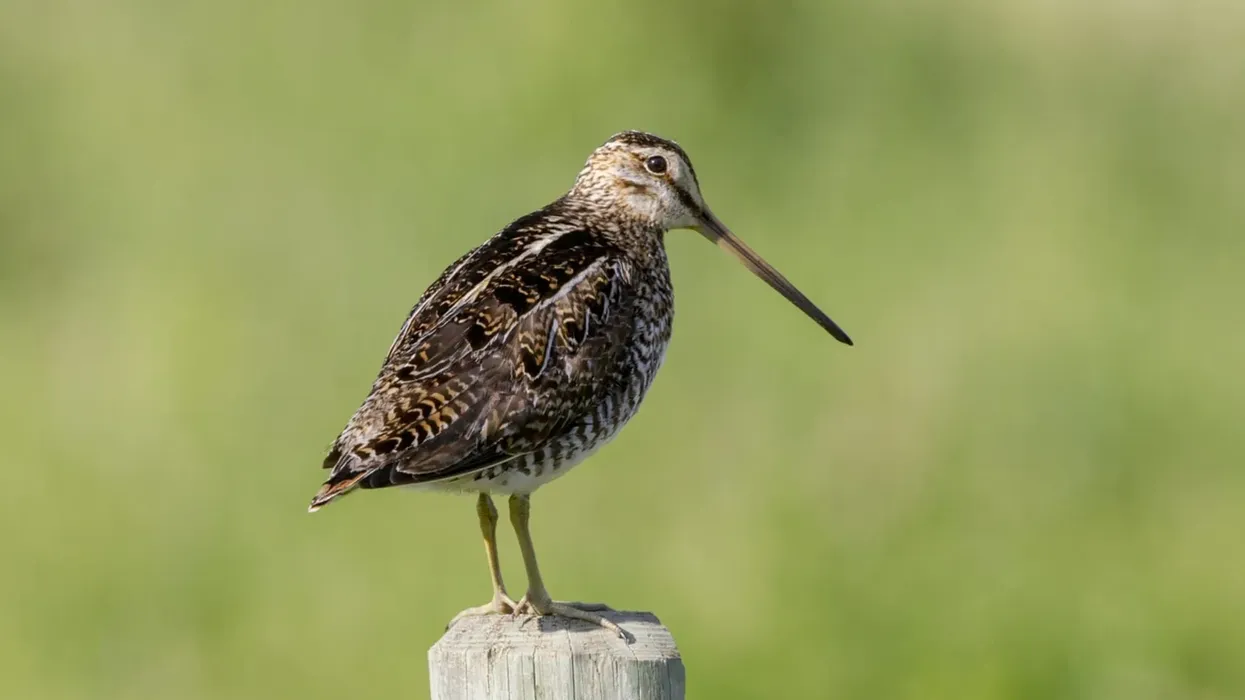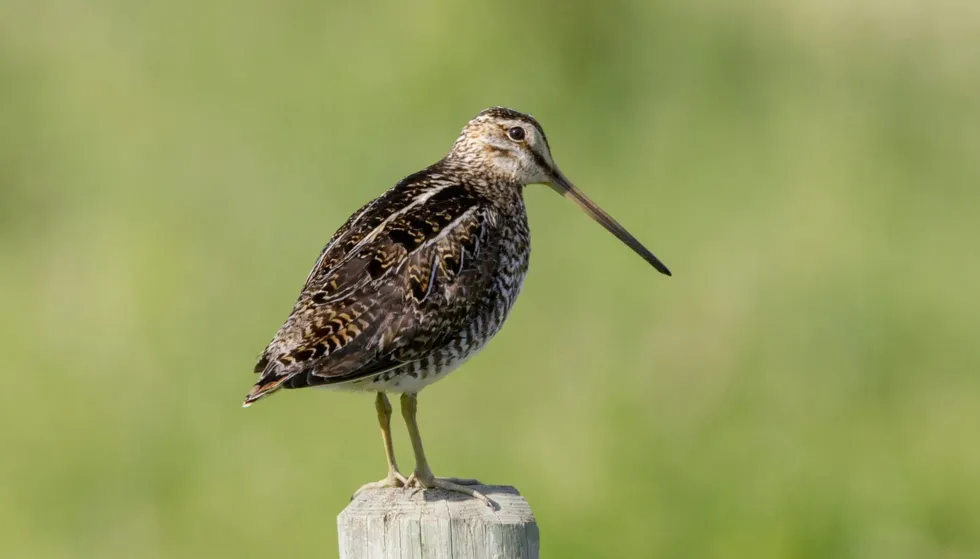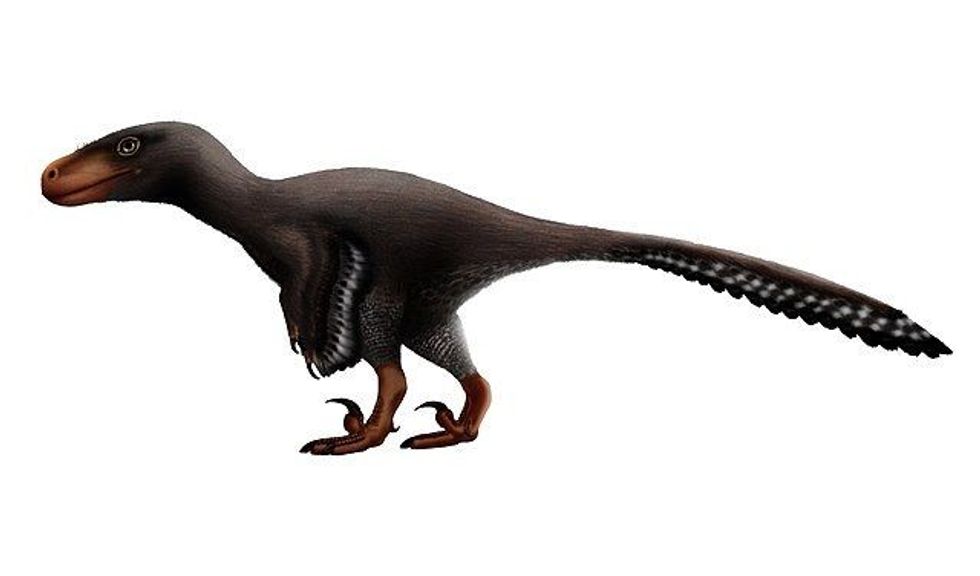The common snipe is a bird that's distributed all over the world, with most populations being found in environments such as marshes, bogs, and wet meadows. The snipe Gallinago species is famous for its slender and extremely long bill and this bird species is commonly found all over the Palearctic.
Populations of the birds have also been reported in Asia. They are classified as wading birds
Even though the distribution of these brown birds is worldwide, they are most commonly found in places with wet environments, such as wet meadows, shallow ponds, rivers, estuaries, marshes, grassy edges of water bodies, and bogs.
In Europe, they are commonly found in the British Isles, Russia, north Portugal, north Italy, central France, and Ukraine. In Asia, they are commonly found in the Middle East and Afghanistan.
They are migratory birds, and most populations that live north of the equator tend to come down south during the winter months when the northern hemisphere becomes significantly colder.
If you're interested in birds and have been curious about knowing more about the common snipe bird species, you're at the right place. In this Kidadl article, we're going to take you through the most interesting common snipe bird facts for kids.
From information about their migration to their bill to their breeding season - you'll find it all here.
For more interesting facts-based articles right here on Kidadl, check out common snipe facts and willet facts.
Snipe Interesting Facts
What type of animal is a snipe?
The snipe is a bird species.
What class of animal does a snipe belong to?
The snipe belongs to the class of animals known as birds.
How many snipes are there in the world?
According to estimates, the global snipe population is approximately 15-29 million.
Where does a snipe live?
Most snipe populations in the world are found in wetlands and marshes.
What is a snipe's habitat?
Snipes are typically found in wetlands, particularly in marshy environments in both the north and the south. Most snipe populations are found in shallow ponds, coastlines, wet meadows, bogs, swamps, and marshes. These birds are known to avoid environments with dense vegetation, preferring the habitat with limited vegetation for evading their predators.
Who do snipes live with?
Snipes are birds that typically live in packs and flock together in large groups during feeding.
How long does a snipe live?
The average lifespan of a snipe ranges from 4-16 years.
How do they reproduce?
Snipes are monogamous birds. Male snipes are known for performing courtship displays during the breeding season known as 'winnowing', which are followed by high flights and shallow dives.
During the dives, these birds generate a drumming sound through the vibration of the feathers on their tails. A male and female typically engage in intercourse following this performance, after which the female gives birth to four eggs. The eggs typically take around three weeks to be incubated.
Both parents look after the young for the first 10-20 days, during which the young tend to be helpless. However, after the initial 10-20 day period, the young in the family start to fly.
What is their conservation status?
Presently, the conservation status of snipes is of Least Concern according to the IUCN.
Snipe Fun Facts
What do snipes look like?

The common snipe is a bird species that are known for its brown plumage with stripes that are yellow-colored. The crown has a central stripe, which is typically paler in comparison to the other stripes on its body.
The bill of this bird species is undoubtedly its most striking physical feature, which is something that it has in common with other snipe subspecies as well, such as Wilson's snipe. The bill is dark, long, and extremely slender, and the bills of females tend to be longer than those of the males.
They have dark brown irises. They have greenish-gray and short legs.
How cute are they?
Due to their small size and stature, snipes are bird species that appear quite cute. However, don't let their appearance fool you. They are quite adept when it comes to hunting and are also known for their escaping skills, and they are quick to evade potential predators.
How do they communicate?
Snipes are bird species that tend to communicate most with each other during dawn and dusk - the two periods of the day during which they are the most active. This species is known to communicate through a series of calls which tends to be long and loud.
How big is a snipe?
The average length of a snipe is 9.8-10.6 in (25-27 cm). Compared to the golden eagle, which has a length of 26-40 in (66-100 cm), the common snipe is three to four times smaller.
How fast can a snipe move?
Snipes include a variety of subspecies. While the speeds of all subspecies are yet to be ascertained, scientists have found that the great snipe can achieve peak speeds of 60 mph (97 kph) during migration. The most amazing thing about the Great Snipe is that it can sustain this speed for the entire duration of the flight.
How much does a snipe weigh?
On average, snipes weigh around 0.17-0.30 lb (80-140 gm).
What are the male and female names of the species?
There aren't any sex-specific names for male and female snipes. Both sexes are referred to as snipes.
What would you call a baby snipe?
You would call a baby snipe a chick.
What do they eat?
Most snipes are insectivorous, while some may be carnivorous as well. Their food typically includes insect larva (like hag moths), worms, and certain other invertebrates. Occasionally, they may also consume plant matter as food. Most of their feeding is done during the hours of dawn and dusk when they hunt insects and other invertebrates in the soft mud.
Are they dangerous?
Common snipes aren't known for being very dangerous. However, when hunting for food, they can be quite rapid. They also have erratic flight patterns, which make it difficult for their prey to judging their approach.
Would they make a good pet?
Snipes thrive out in the open and while you can definitely pet one, we recommend letting the snipes be in their natural habitat, as they are shy beings who like to live with their own kind.
Did you know...
Even though the snipe is a bird whose conservation status is Least Concern, reports from the recent past suggest that their numbers are on the way down. The most noticeable decline in snipe populations has been reported in certain parts of Europe such as Germany and England, especially the areas where agricultural infestation and field drainages have been reported.
In other areas of the world such as North America and South America, snipe populations are declining primarily due to hunting, as the brown birds as popular gamebirds.
Different types of snipe
The most common snipe species is Gallinago, which is abundantly distributed across the world. However, there are various other subspecies as well, like the jack snipe.
Just like common snipe is mostly found across Europe and Asia, jack snipe is also found around southern Europe and parts of Asia and Africa. There are very minor differences between the different species, with most features being common.
Do snipes fly?
Snipes are known to fly vast distances, particularly during the migration season. However, during other seasons, they mostly prefer to stay close to land, taking flight only to avoid potential threats on land.
Here at Kidadl, we have carefully created lots of interesting family-friendly animal facts for everyone to discover! For more relatable content, check out these limpkin facts and stork facts for kids.
You can even occupy yourself at home by drawing one on our free printable common snipe coloring pages.









